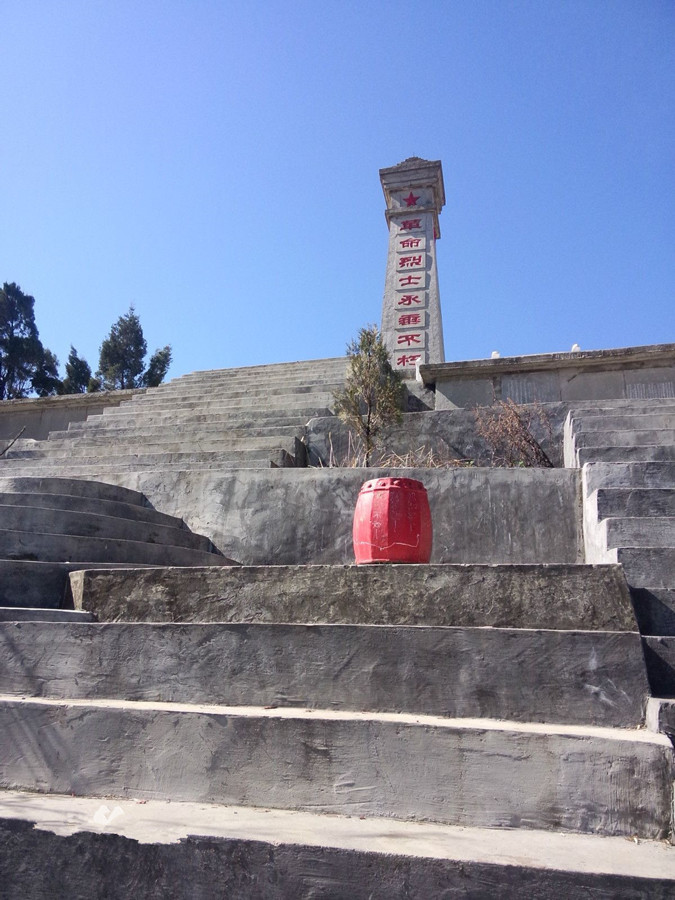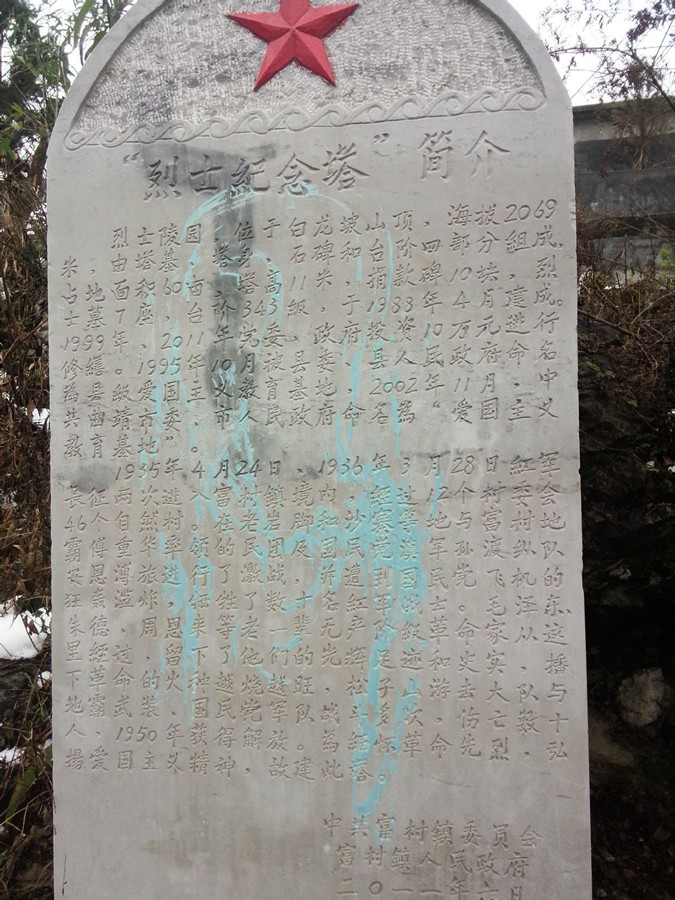
Fucun Martyrs’Cemetery in Fuyuan County, Qujing
Overview
The Fucun Martyrs’ Cemetery (富村烈士陵园纪念塔) is located at the summit of Bailongpo Mountain (白龙坡山), standing at an elevation of 2069 meters. The cemetery consists of four main parts: the base, the tower body, stone tablets, and steps, covering an area of 60 acres. The tower is 11 meters tall and features ten donation stones, seven martyrs’ graves, and 343 steps. It was completed in April 1988. The cemetery underwent renovations in 1999 and 2011, funded by the local government, and received further investment in 2014.
In October 1995, it was designated as a county-level patriotic education base by the county committee and government. In November 2002, the Qujing Municipal Committee and Municipal Government recognized it as a “Patriotic Education Base.”
Monument Details
- Eastern Side: Inscribed with “The revolutionary martyrs will live forever.”
- Western Side: Features a relief pattern of a red flag and a five-pointed star.
- Southern Side: Inscribed with “1935,” symbolizing the year the Red Army entered Fucun.
- Northern Side: Inscribed with “1950,” symbolizing the year Fucun was liberated.
- Surrounding the Base: Inscribed with various texts, construction explanations, and the names of 68 martyrs.
Approximately 300 meters southwest of the tower lies a series of seven graves. While three of these graves are named, the others remain unmarked for unknown martyrs. Every Qingming Festival (Tomb-Sweeping Day), local officials, students, and residents visit the cemetery to pay their respects and promote patriotic education.
Historical Significance
On April 24, 1935, and March 28, 1936, the Red Army (红军) crossed into Fucun during their Long March, passing through 12 village committees and 46 natural villages. Intense battles occurred at locations such as Laoyanjiao and Shazhai against local warlord Fu Zhonghua (傅重华) and the Nationalist forces. Many Red Army soldiers lost their lives during aerial bombardments by the Nationalist aircraft. Prominent revolutionary leaders like Mao Zedong (毛泽东), Zhu De (朱德), and Zhou Enlai (周恩来) traversed this area, leaving a profound historical legacy and igniting the revolutionary spirit. The local guerrilla group, Songzi Mountain Guerrilla Team (松子山游击大队), engaged in numerous battles against the warlord’s forces and the Nationalist army, culminating in the liberation of Fucun in 1950.
To commemorate these revolutionary martyrs and promote patriotic spirit, the monument was established.
Long March and Revolutionary Fire
From October 1934 to October 1935, the Chinese Communist Party led the famous 25,000-mile Long March, during which the Central Committee held an important meeting in Zunyi, solidifying Mao Zedong’s leadership. The Red Army executed strategic maneuvers, including four crossings of the Chishui River and a southern passage across the Wujiang River, eventually entering Yunnan.
On April 24, 1935, the Red Army entered Fucun District, engaging in battles with local forces across various villages and enduring significant casualties. The historical significance of the Long March is not only a military achievement but also a declaration of revolutionary ideals, as reflected in Mao Zedong’s assertion that “the Long March is a manifesto, a propaganda team, and a sowing machine.”
Liberation War and Local Resistance
The Red Army’s Long March sowed the seeds of revolution, leading to persistent struggles against oppressive landlords and local tyrants, especially during the autumn of 1947 when the local anti-Japanese guerrilla warfare rapidly developed. New bases were established, and numerous guerrilla teams formed to promote communist policies and engage in battles against Nationalist forces.
Despite the oppressive actions of local warlord Fu Zhonghua, who collaborated with enemy forces, the guerrilla fighters showed resilience. Several fierce battles ensued, resulting in numerous victories against the oppressive regime, although significant sacrifices were made.
Martyrs’ List
Due to difficulties in verifying names and residences, foreign martyrs who fought in Fucun and perished in the liberation war are not individually commemorated. However, the following list has been confirmed by various levels of government as martyrs:
- Feng Yulin (冯玉林), from Fucun Township, Fuyuan County
- Yang Zhengguo (杨正国), from Fucun Township, Fuyuan County
- Liao Heyuan (廖黑元), from Fucun Township, Fuyuan County
- Yue Wenzhu (岳稳柱), from Juhen Township, Fuyuan County
- Hou Erde (候二德), from Juhen Township, Fuyuan County
- Guo Zhengming (郭正明), from Desheng Township, Fuyuan County
- Wang Sanwei (王三维), from Songzi Mountain Township, Fuyuan County
- …
(For brevity, the full list is not included here.)
How to Get There
To reach the Fucun Martyrs’ Cemetery:
- By Car: Drive to Fuyuan County from Qujing City, following the local road signs towards Bailongpo Mountain.
- By Public Transport: Take a bus from Qujing to Fuyuan County and then use local transport to reach the cemetery.
Travel Tips
- Best Time to Visit: Spring and autumn offer pleasant weather for visits. Be sure to attend during Qingming Festival for local commemorations.
- Dress Appropriately: Wear comfortable shoes for walking up the mountain.
- Respect the Site: As a site of remembrance, maintain a respectful demeanor and follow local customs when visiting.
- Bring Supplies: Consider bringing water and snacks, as facilities may be limited in the area.



 7 Days GolfingTour
7 Days GolfingTour
 8 Days Group Tour
8 Days Group Tour
 8 Days Yunnan Tour
8 Days Yunnan Tour
 7 Days Shangri La Hiking
7 Days Shangri La Hiking
 11 Days Yunnan Tour
11 Days Yunnan Tour
 6 Days Yuanyang Terraces
6 Days Yuanyang Terraces
 11 Days Yunnan Tour
11 Days Yunnan Tour
 8 Days South Yunnan
8 Days South Yunnan
 7 Days Tea Tour
7 Days Tea Tour
 8 Days Muslim Tour
8 Days Muslim Tour
 12 Days Self-Driving
12 Days Self-Driving
 4 Days Haba Climbing
4 Days Haba Climbing
 Tiger Leaping Gorge
Tiger Leaping Gorge
 Stone Forest
Stone Forest
 Yunnan-Tibet
Yunnan-Tibet
 Hani Rice Terraces
Hani Rice Terraces
 Kunming
Kunming
 Lijiang
Lijiang
 Shangri-la
Shangri-la
 Dali
Dali
 XishuangBanna
XishuangBanna
 Honghe
Honghe
 Kunming
Kunming
 Lijiang
Lijiang
 Shangri-la
Shangri-la
 Yuanyang Rice Terraces
Yuanyang Rice Terraces
 Nujiang
Nujiang
 XishuangBanna
XishuangBanna
 Spring City Golf
Spring City Golf
 Snow Mountain Golf
Snow Mountain Golf
 Stone Mountain Golf
Stone Mountain Golf


















